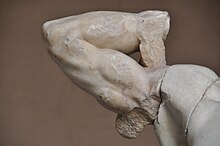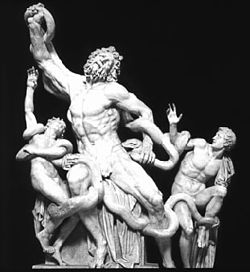Ludwig Pollak

Ludwig Pollak (14 September 1868, Prague – circa October 23, 1943,[1] Auschwitz concentration camp) was an Austro-Czech classical archaeologist, antiquities dealer, and director of the Museo Barracco di Scultura Antica in Rome.[2]


Biography
He is perhaps best known for discovering in 1906 the missing right arm of Laocoön in the famous ancient Roman sculpture Laocoön and His Sons. The rest of the statue had been discovered in 1506, with the arm as well as several other pieces, including the arms of the sons and parts of the snake, missing.[3] The Renaissance sculptor Michelangelo had correctly suggested that the missing right arms were originally bent back over the shoulder; however, most others disagreed, opting for a reconstructed arm in an heroic extended fashion.[3]: 7–11 This incorrectly reconstructed arm was added to the statue.
In 1906, Pollak discovered a fragment of a marble arm in a builder's yard in Rome, close to the findspot of the rest of the statue. Noting a stylistic similarity to the Laocoön group he presented it to the Vatican Museums: it remained in their storerooms for half a century. In 1957 (after Pollak's murder at Auschwitz) the museum decided that this arm—bent, as Michelangelo had suggested—had originally belonged to this Laocoön, and replaced it. According to Paolo Liverani: "Remarkably, despite the lack of a critical section, the join between the torso and the arm was guaranteed by a drill hole on one piece which aligned perfectly with a corresponding hole on the other".[2]
Ludwig Pollak's story forms the basis of the 2021 German novel, Pollaks Arm by Hans Von Trotha [de] (English translation by Elizabeth Lauffer
- Machine translation, like DeepL or Google Translate, is a useful starting point for translations, but translators must revise errors as necessary and confirm that the translation is accurate, rather than simply copy-pasting machine-translated text into the English Wikipedia.
- Do not translate text that appears unreliable or low-quality. If possible, verify the text with references provided in the foreign-language article.
- You must provide copyright attribution in the edit summary accompanying your translation by providing an interlanguage link to the source of your translation. A model attribution edit summary is
Content in this edit is translated from the existing German Wikipedia article at [[:de:Ludwig Pollak]]; see its history for attribution. - You may also add the template
{{Translated|de|Ludwig Pollak}}to the talk page. - For more guidance, see Wikipedia:Translation.
References
- ^ a b Oren, Dan A. (2018). The Wedding Photo. Connecticut: Rimmon Press. ISBN 978-0-692-13981-3. OCLC 1046657980.
- ^ a b Liverani, Paolo. "Catalogue Entry: Laocoon Group". Digital Sculpture Project.
- ^ a b Barkan, Leonard (1999). Unearthing the Past: Archaeology and Aesthetics in the Making of Renaissance Culture. Yale University Press. ISBN 9780300089110.
External links
- The Barracco-Pollak Library (Sovraintendenza ai Beni Culturali Roma site)
- Works by and about Pollak[permanent dead link] in the Deutschen Nationalbibliothek










